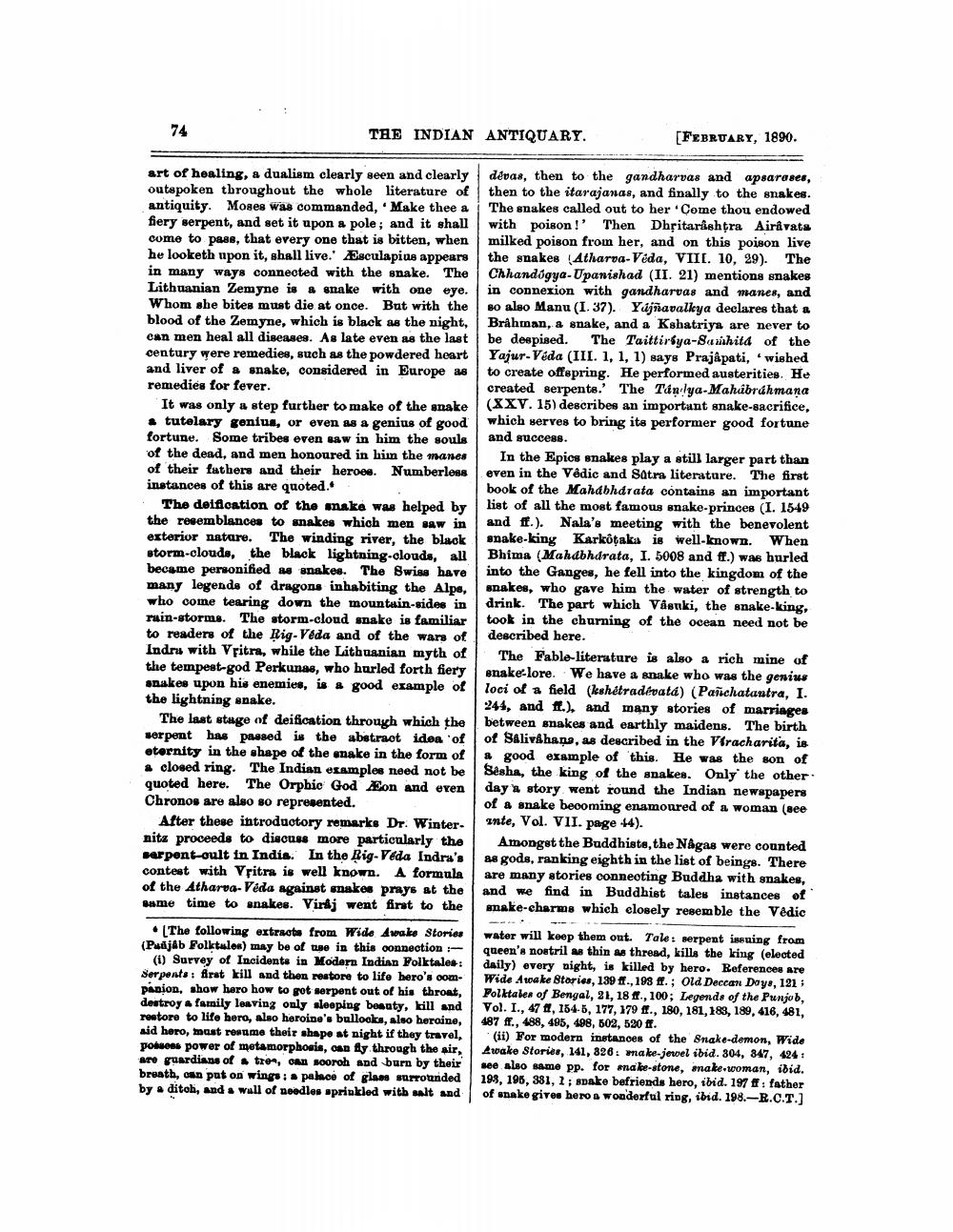________________
74
THE INDIAN ANTIQUARY.
[FEBRUARY, 1890.
art of healing, a dualism clearly seen and clearly devas, then to the gandharvas and apsarases, outspoken throughout the whole literature of then to the itarajanas, and finally to the snakes. antiquity. Moses was commanded, Make thee a ¡ The snakes called out to her 'Come thou endowed fiery serpent, and set it upon a pole; and it shall with poison !' Then Dusitarishtra Airivats come to pass, that every one that is bitten, when milked poison from her, and on this poison live he looketh upon it, shall live.' Æsculapius appears the snakes (Atharva-Veda, VIII. 10, 29). The in many ways connected with the snake. The Chhandigya-Upanishad (II. 21) mentions snakes Lithuanian Zemyne is & snake with one eye. | in connexion with gandharvas and manes, and Whom she bites must die at once. But with the so also Manu (I. 37). Yajñavallya declares that a blood of the Zemyne, which is black as the night, Brahman, a snake, and a Kshatriya are never to can men heal all diseases. As late even as the last be despised. The Taittirsya-Sanhitd of the century were remedies, such as the powdered heart Yajur Veda (III. 1, 1, 1) says Prajapati, wished and liver of a snake, considered in Europe as to create offspring. He performed austerities. He remedies for fever.
created serpente.' The Tán lya Mahabráhmana It was only a step further to make of the snake (XXV. 15) describes an important snake-sacrifice, . tutelary genius, or even as a genius of good
which serves to bring its performer good fortune fortune. Some tribes even saw in him the souls
and success of the dead, and men honoured in him the manes In the Epios snakes play a still larger part than of their fathers and their heroes. Numberless even in the Vedic and Satra literature. The first instances of this are quoted.
book of the Mahabhdrata contains an important The defloation of the maka was helped by
list of all the most famous snake-princes (I. 1549 the resemblances to snakes which men saw in and ff.). Nala's meeting with the benevolent exterior natare. The winding river, the black snake-king Karkötaka is well-known. When storm-clouds, the black lightning-clouds, all Bhima (Mahabharata, I. 5008 and ff.) was hurled became personified as snakes. The Swiss have into the Ganges, he fell into the kingdom of the many legends of dragons inhabiting the Alps, snakes, who gave him the water of strength to who come tearing down the mountain-sides in drink. The part which Våenki, the snake-king, rain-storms. The storm-cloud snake is familiar took in the churning of the ocean need not be to readers of the Rig Veda and of the wars of described here. Indru with Vitra, while the Lithuanian myth of The Fable-literature is also a rich mine of the tempest-god Perkunae, who hurled forth fiery snake-lore. We have a snake who was the genius snakes upon his enemies, is a good example of loci of a field (kshetradératá) (Paschatantra, I. the lightning anake.
244, and 1.), and many stories of marriages The last stage of deification through which the between snakes and earthly maidens. The birth serpent has passed is the abstract idea of of Salivahana, as described in the Viracharita, is eternity in the shape of the enake in the form of a good example of this. He was the son of
closed ring. The Indian examples need not be Sesha, the king of the snakes. Only the other quoted here. The Orphic God Æon and even day story went round the Indian newspapers Chronos are also so represented.
of a snake becoming enamoured of a woman (see After these introductory remarks Dr. Winter Inte, Vol. VII. page 44). nita proceeds to discuss more particularly the Amongst the Buddhists, the Nagas were counted Serpont-oult in India. In the Rig Veda Indra's 88 gode, ranking eighth in the list of beings. There contest with Vritra is well known. A formula are many stories conneoting Buddha with snakes, of the Atharva-Veda against snakes prays at the and we find in Buddhist tales instances of
ne time to snakes. Viraj went first to the snake-charms which closely resemble the Vedic • [The following extracts from Wide Awake Stories water will keep them out. Tale: serpent issuing from (Psdjáb Folktaler) may be of the in this connection:- queen'a nostril as thin a thread, kills the king (elected
(1) Survey of Incidents in Modern Indian Folktales: daily) every night, is killed by hero. References are Serpents: Arst kill and then restore to life hero's oom- Wide Awake Stories, 139 ff., 198 ff.; Old Deccan Doys, 121 papion, show hero how to get serpent out of his throat, Polktalen of Bengal, 21, 18 f., 100; Legends of the Punjob, destroy a family leaving only sleeping beauty, kill and Vol. I., 47 , 154-5, 177, 179 ff., 180, 181, 183, 189, 416, 481, restore to life bero, also heroine's bullocks, also heroine, 187 , 188, 185, 198, 502, 520 ff. aid hero, mast resume their shape at night if they travel, (ii) For modern instances of the Snake-demon, Wide potuces power of metamorphosis, an fly through the air, Awake Stories, 141, 826: make-jewel ibid. 304, 847, 424 : are guardians of tron, OAU sooroh and burn by their see slao same pp. for make-stone, make woman, ibid. breath, can put on wings: – palace of glass surrounded 193, 198, 381, 2; spake befriends hero, ibid. 197 ff : father by . ditoh, and wall of needles sprinkled with salt and of snake given hero a wonderful ring, ibid. 198.-R.O.T.]




